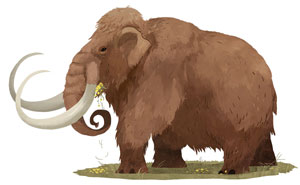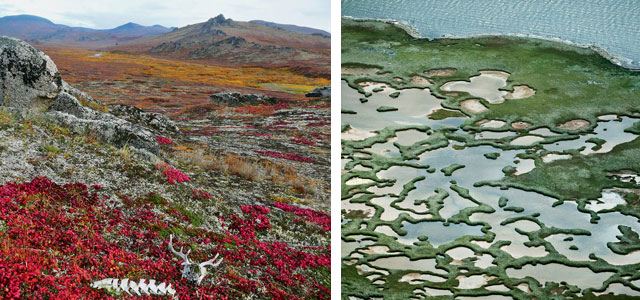sierraclub.org - sierra magazine - jan/feb 2013 - in beringia
Searching the Arctic for a long-lost world of woolly mammoths and giant sloths, a traveler discovers a new one disappearing fast
Text by Edward Readicker-Henderson | Illustrations by Aleks Sennwald
 On the road from Nome to Teller, Alaska, all the musk oxen have moved up the hills, trying to turn back time and seasons with a change of altitude. But reindeer, descendants of a herd imported by a misguided but well-meaning missionary more than 100 years ago, completely block my way. The clicks of their anklebones, the shake of muscle, sound like sleigh bells. They trot toward the truck until they're close enough for me to smell them—it's like fresh blueberries mixed with dryer lint—and then all turn at once, giving up the hard-packed dirt for the tussocky tundra. Within yards, their autumn-mottled fur looks ghostly against the landscape.
On the road from Nome to Teller, Alaska, all the musk oxen have moved up the hills, trying to turn back time and seasons with a change of altitude. But reindeer, descendants of a herd imported by a misguided but well-meaning missionary more than 100 years ago, completely block my way. The clicks of their anklebones, the shake of muscle, sound like sleigh bells. They trot toward the truck until they're close enough for me to smell them—it's like fresh blueberries mixed with dryer lint—and then all turn at once, giving up the hard-packed dirt for the tussocky tundra. Within yards, their autumn-mottled fur looks ghostly against the landscape.
I'm on this road, an off-ramp of what used to be the Bering Land Bridge, because in 1901, on the other side of the Bering Strait—way past where long-tailed jaegers hover like broken kites—a man named Otto F. Herz dug up a woolly mammoth.
Back then that wasn't so unusual in Alaska, Russia, and the Yukon Territory. In fact, so many mammoth bones and tusks were found during the Klondike gold rush that someone built a cabin out of them. Herz's find was different, though: not a skeleton but almost an entire animal preserved in permafrost.
And so now I'm on an off-ramp to the Bering Land Bridge, because when they looked closely, the mammoth still had a mouthful of buttercups.

Two faces of Alaska's Bering Land Bridge National Preserve: a caribou skeleton near Serpentine Hot Springs (left) and the quickly eroding Chukchi Sea coastline, not far from the vanishing seaside village of Shishmaref.
But the very phrasing is wrong, a lie. "The Bering Land Bridge," they told us in grade school. And everybody I've ever talked to pictured pretty much the same thing: a strip of land, maybe just wide enough for three or four people to walk abreast, reaching out from Asia to America like the finger of God on the ceiling of the Sistine Chapel.
The Bering Land Bridge wasn't a bridge at all, though; it was simply dry land where the shallow Bering Sea is now. As many as 600 miles from north to south, it didn't connect two continents but rather created a single place, Beringia, an environment that stretched from around the Lena River, in what's now northeastern Siberia, to the Mackenzie River, roughly the current border of Canada's Yukon and Northwest Territories. Along the way, it more or less straddled the Arctic Circle.
Completely surrounded by glaciers, Beringia was a contained, warmer world of ground sloths the size of cars, of woolly mammoths and lions and scimitar cats with teeth curved as if drafted by a protractor. Small horses darted through low grass.
And here, the first people walked from what we now call the old world to the new. But there could have been no sense of arrival, because at the time there was only one world.
Think of that lovely phrase from Thoreau: "I wish to know an entire heaven and an entire earth." That was Beringia.
Each trip has revealed a landscape changed. It's as if I'm watching a horror film on fast-forward.
Then, about 10,000 years ago, the glaciers melted. The temperature warmed. The sea filled. And the last entire earth disappeared.
A dozen years ago, when I first came to Beringia after reading about Herz, I walked into the Bering Land Bridge National Preserve office in Nome and said, "I need a mammoth." For some reason, that made perfect sense to the ranger. He took me into a back office where a tusk lay, about five feet long, as thick as a baseball bat at one end, tapering to a fine point at the other. When the mammoth was alive, the tusk was a clean ivory. But over the past 10,000 to 40,000 years, it has absorbed minerals and traded molecules and turned pale blue, like a powdery sunset gleaming against a glacier.
The blue is a fairly basic chemical reaction: The mineral vivianite likes it when the organic remains of animals, which are low in iron and high in phosphates, end up buried in soil that's rich in iron and phosphate-poor. Mix in oxygen, get the blue—one of those rare occasions when time and loss conspire to add beauty.
"Okay, here's what you're going to do," the ranger said. "Right after spring breakup, get a thirty-ought-six. Then walk the streambeds. Look along the line where the ice has stripped away the banks. Sooner or later, you'll see a bone or a tusk sticking out. Shoot all around it to loosen the permafrost." Then he realized I was writing this down, and I had his name. "I'm going to need my business card back," he said.
And so, year after year, I've gone back. I've walked streambeds in Beringia. I've traveled from the edge of the Yukon to the Bering Sea. I've interviewed every expert I could get to spare a few minutes of time. The short and easy reason is that I'm hoping that no world is ever completely lost. The longer, more complicated reason is that, despite all hope, I know I'm watching a world disappear, and I can't take my eyes off it. Each trip has revealed a landscape changed. It's as if I'm watching a horror film on fast-forward. Rivers I walked alongside a decade ago that had no plants on the banks higher than the blueberries staining my shoes are now lined with willows too tall to see over.
Courtesy of the National Park Service (2)
1 | 2 | 3 | next >>